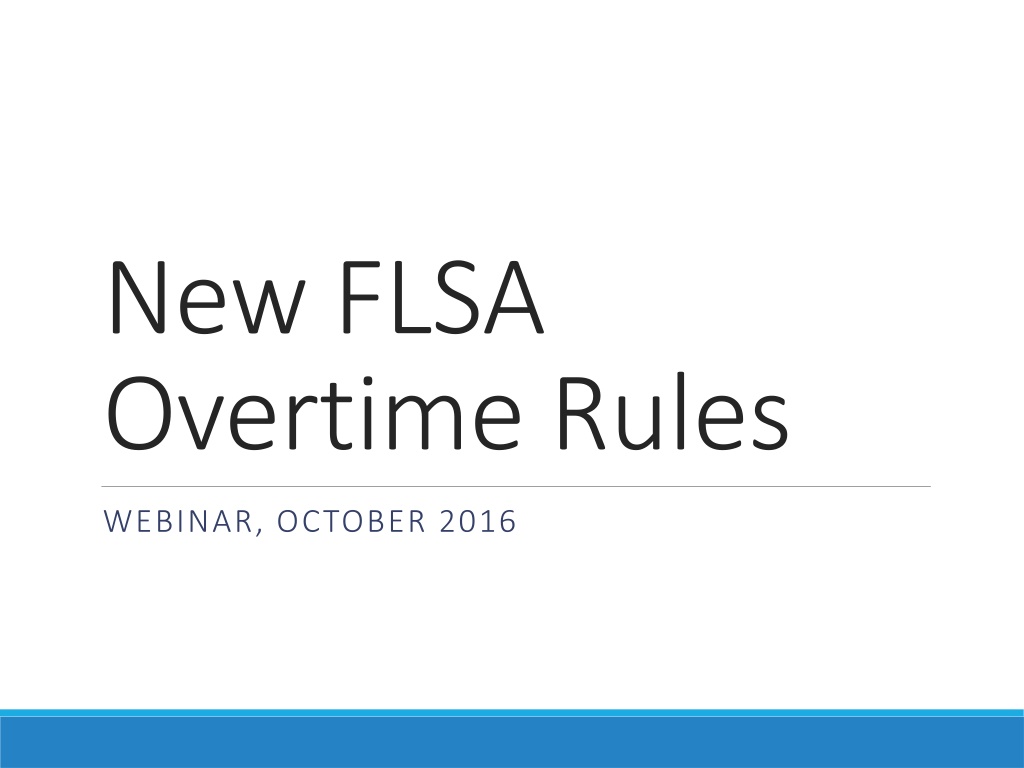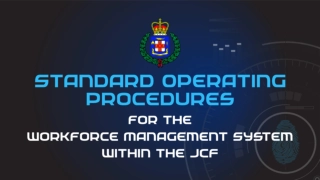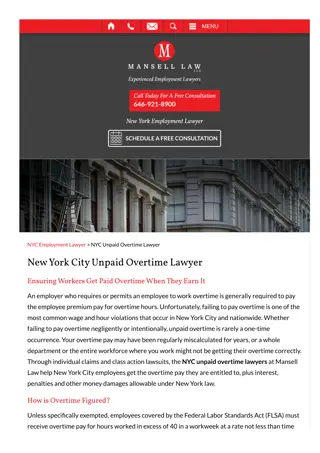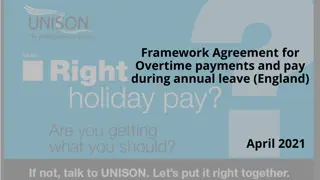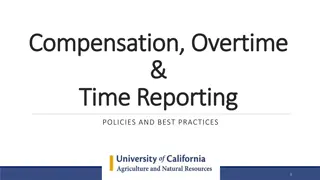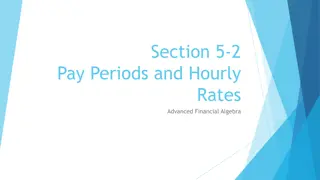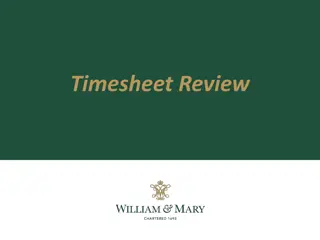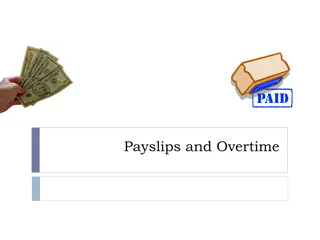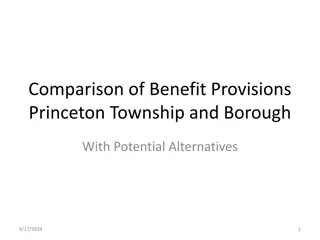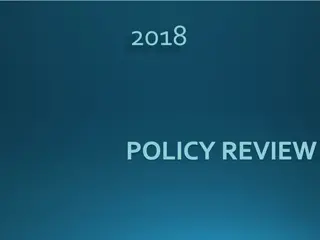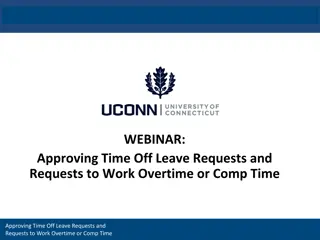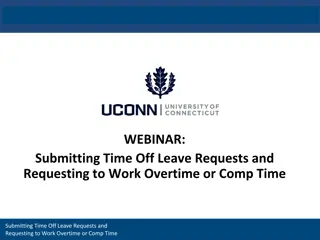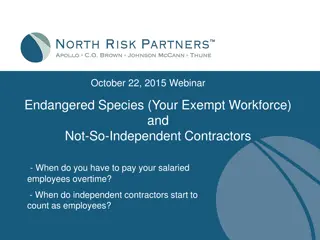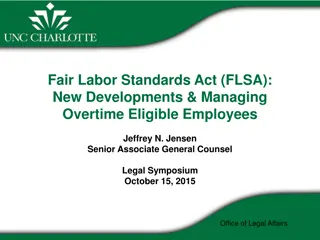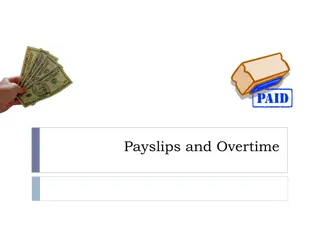Understanding the New FLSA Overtime Rules: Implementation Guidelines
The Fair Labor Standards Act (FLSA) has introduced new overtime rules effective December 1, 2016, impacting employees previously exempt. The changes include raising the salary threshold for overtime eligibility and creating new job class codes. This summary highlights key aspects such as the background of the FLSA, affected employees, implementation steps, and the development of new class codes to ensure compliance with the updated regulations.
Uploaded on Sep 21, 2024 | 0 Views
Download Presentation

Please find below an Image/Link to download the presentation.
The content on the website is provided AS IS for your information and personal use only. It may not be sold, licensed, or shared on other websites without obtaining consent from the author. Download presentation by click this link. If you encounter any issues during the download, it is possible that the publisher has removed the file from their server.
E N D
Presentation Transcript
New FLSA Overtime Rules WEBINAR, OCTOBER 2016
Outline Background on the changes Steps for implementation during the 11/18/16 pay period & forward How to complete forms (such as the Hiring Justification, Position Description Questionnaire, M-40) How to enter positions in the applicant tracking system Setting up positions in HRIS Procedures for when an employee crosses the wage threshold Data Warehouse reports Summary and Questions
Background The Fair Labor Standards Act (FLSA) is a federal law that provides minimum wage and overtime pay protections to covered employees. Employees are either FLSA covered, or FLSA exempt. To be exempt from FLSA, an employee must meet three tests : 1. Salary Basis: Guaranteed minimum for work performed. 2. Duties: White collar (executive, administrative, and professional) employees. 3. Salary Level: Earn more than $455 per week ($910 biweekly). The new rule changes the salary level test threshold. The salary level will automatically update every three years and is equal to the 40th percentile of earnings of full-time salaried workers in the lowest- wage Census Region (which is currently the South).
Background What: A new rule from the Department of Labor (DOL) will expand premium overtime eligibility to employees who were previously FLSA exempt. The rule raises the salary threshold below which salaried, white collar employees are eligible for overtime. The threshold has increased from $455 per week ($910 biweekly) to $913 per week ($1,826 biweekly). Who is impacted: Employees in job classes currently exempt from premium overtime pay who earn between $910 and $1,826 biweekly. 104 job classifications affected; approximately 170 total employees affected When: The new rule is effective December 1, 2016, which falls in the November 18, 2016, pay period. How: New class codes have been established in the 50000 series for current FLSA exempt job classes with a minimum salary of less than $1,826 biweekly. These new class codes are in addition to, not in place of, the existing class codes of the affected job classes.
Implementation A new M5 and P1 type have been developed specifically for the rule change. M5 type: 260 FLSA Class Code Change (265 for Judicial branch) P1 type: 694 FLSA Class Code Change (695 for Judicial branch) Employees in the affected job classes who currently earn less than $1,826 biweekly must be moved to the 50000 series class code for their job class effective with the November 18 pay period (a list of the affected employees will be provided to you prior to this pay period). A list of the affected job classes and the new 50000 series class codes can be found at: https://das.iowa.gov/sites/default/files/hr/documents/class_and_pay/FLSA ChangeJobClasses.pdf Agency Human Resource Associates (HRAs) will also need to begin monitoring the salaries of employees in the 50000 series class codes, and pay close attention to the starting salary of any employee hired into one of the affected job classes to make sure the appropriate class code is used.
Implementation Timeline Once HRAs receive the list of affected employees, a 260 FLSA Class Code Change M5 must be written for each employee. The effective date of the M5 must be 11/18/2016. The class code entered on the M5 must be the 50000 series class code that corresponds to the employee s job class and current class code. After the 260 FLSA Class Code Change M5 has processed, the HRA must write a 694 FLSA Class Code Change P1. All 260 FLSA Class Code Change M5s must be written and approved at the PA and DEPT levels by no later than Thursday, December 1. All 694 FLSA Class Code Change P1s must be written and approved at the PA and DEPT levels by no later than Friday, December 2.
Impact on HRIS Time Reporting Implementation during the 11/18/2016 Pay Period After both the M5 and P1 have processed on the employee during the 11/18/2016 pay period, the current timesheet will need to be cancelled and a new timesheet written. Since the employee will have their overtime eligibility changed when they move from their existing class to the 50000 series class, which makes them eligible for premium overtime, there are online edits on the timesheet that will reflect their new eligibility. Cancelling and rewriting the timesheet will ensure all edits are working properly and the employee is accurately paid during the 11/18/2016 pay period. Ongoing process for Time Reporting Each pay period that a department moves an employee to/from an FLSA exempt class code to a 50000 series class code, and vice versa, the current timesheet will need to be cancelled and rewritten after both the M5 and P1 have been processed. Again, this is due to the change in overtime eligibility and the online edits on the time reporting system. If your department uses PAYN, any entries made before the M5 and P1 are processed will need to be reentered after both the M5 and P1 have processed (this is the same as now when a reclassification is processed on a PAYN employee).
260 FLSA Class Code Change M5 D3325561 ACT: _ +--- POSITION CHANGE (M-5) -- +-------- M-5 TYPE --------+ PRINTER: | 005-C85-5330-00311-002 | 260 FLSA CLASS CHG | +--------------------| M-5 NUMBER....: 01-2345 |------ APPROVED BY -------| | M-5 STATUS | EFFECTIVE DATE: 11/18/2016 | PA DEPT COMP PROC | | PENDING PA APPROVA | COST CENTER...: 005-542004 | NO NO +---------------------+----------------------------+--------------------------+ REMARKS: EMPLOYEE NAME NEW FLSA RULE IMPLEMENTATION NO NO | ---------------- F R O M ---- ---- D E S C ---- ---- T O -------PAGE : 1 OF 6 005 | AGENCY | C85 | APPROP UNIT | 5330 | ORG CODE | ACCOUNTANT 2 00311 | CLASS CODE | 50311 ACCOUNTANT 2 002 | SEAT NUMBER | 002 DAS COST CENTER 005-542004 | COST CENTER | - PERM FULL TIME-MERT 00 | POSITION TYPE*| CONTRACT COVERED N | POSITION ELIG*| P-5 APPROVED 1 | FUNDING CODE* | NOT FIELD STATUS N | FIELD STATUS* | 1.000 | FTE | | | * INDICATES SELECTION LIST ------------------------------------------------------------------------------ O POS INFO L ACT LOG H HRD CPY P PROOF Y APPROVE N UNAPPROVE C CANCEL D DENY R REMARKS S SEL LIST P1 P-1S PF7 BKWD PF8 FWD PF9 HELP PF12 RETURN CLEAR EXIT
694 FLSA Class Code Change P1 D3325065 ACT: _ REPORT OF PERSONNEL ACTION (P-1) | ------- P-1 TYPE ------ PRINTER: L NAME, F NAME MI | 694 FLSA CLASS CHG -- P-1 STATUS -- P-1 NUMBER ........: 1234567 | ----- APPROVED BY ------ NEEDS PA APPV EFFECTIVE DATE ....: 11/18/2016 | PA DEPT COMP PROC OPTIONAL REMARKS* INITIATED BY ......: 005-333331 | NO NO NO NO | REMARKS: NEW FLSA RULE IMPLEMENTATION M5 #28-XXXX | ---------------- F R O M ---- ---- D E S C ---- ---- T O ------- PAGE 1 OF 1 DAS COST CENTER 005-542004 | COST CENTER | - | | 005-C85-5330-00311-002 |POSITION NUMBER| 005-C85-5330-50311-002 26 | PAY GRADE | ACCOUNTANT 2 | CLASS TITLE | 22.27 / HR 1,781.60 | BASE SALARY | 1,781.60 22.27 / HR 00 | BASE STEP | 00 07/14/2017 |STEP INCR. DATE| 07/14/2017 | | | | | | BI-WEEKLY 03 | MODE OF PAY* | 03 BI-WEEKLY | | ---------------------------------------------------- * INDICATES SELECTION LIST ? ACTION HELP PF7 PREV PF8 NEXT PF9 HELP PF12 RETURN CLEAR EXIT
Completing Forms A position number is required on several forms, such as the Hiring Justification, Position Description Questionnaire (PDQ), and Special Pay/Appointment Action (M-40). Effective with the 11/18/16 pay period forward, the position number for a position in one of the affected job classes should be completed on these forms as follows: Hiring Justification: For new positions, use the 50000 series class code in the position number. For existing positions that are being refilled, enter the position number as it currently exists. Position Description Questionnaire: For vacant positions, use the 50000 series class code if the position is new; otherwise, enter the position number as it currently exists. If the PDQ is for a filled position, enter the employee s current position number. DAS will complete the new position number field upon completion of the review. Special Pay/Appointment Action: If submitting an Advanced Appointment Rate (AAR) request, enter what the class code should be if the AAR is approved. For example, if the AAR request is for a biweekly rate of $2,000, use the FLSA exempt class code in the position number. For all other requests, enter the employee s current position number.
Posting Positions When creating a requisition in the applicant tracking system for a vacancy in an affected job class, enter the class code that was used on the hiring justification and PDQ. Once a hire has been made, it is critical that the position number entered on the disposition form has the correct class code based on the employee s starting salary. If the person hired is paid below the $1,826 biweekly threshold, the position number on the disposition form should have the 50000 series class code. If the person hired is paid above the $1,826 biweekly threshold, the position number on the disposition form should have the FLSA exempt class code.
Setting Up Positions in HRIS When you are creating a new position in HRIS for one of the affected job classes, you should always use the 50000 series class code. If the person hired will be paid above the $1,826 biweekly threshold, write a 260 FLSA Class Code Change M5 to change the class code to the FLSA exempt class code. The M5 must process before the hire P1 can be written. When a position in one of the affected job classes becomes vacant, do not do anything to the position number in HRIS until you know the starting salary of the person hired into the position. Once you know the person s starting salary, fix the class code if needed using the 260 FLSA Class Code Change M5. Before writing a hire P1 for an individual hired into one of the affected job classes, double check that the position number has the correct class code based on the employee s biweekly rate of pay. If the salary is less than $1,826 biweekly, the class code must be the 50000 series class code. If the salary is $1,826 or above, the class code must be the FLSA exempt class code.
Setting Up Positions in HRIS Position set-up example 1: A new employee is hired for a non-contract Accountant 2 position (minimum $1,404.80 biweekly) with a 30% advanced appointment. This makes the employee s starting salary $1,826.40 biweekly. This is above the $1,826 biweekly threshold, so the 90311 class code must be used. New Hire: Accountant 2 (non-contract) $2,514.40 Biweekly Accountant 2 Maximum 90311 59311 $1,826.40 Starting Salary (30% AAR) $1,826 Biweekly Threshold $1,404.80 Biweekly Accountant 2 Minimum
Setting Up Positions in HRIS Position set-up example 2: A current employee in an Accounting Technician 3 position is promoted to a contract-covered Field Auditor position. The employee was earning $1,657.60 biweekly as an Accounting Technician 3, and will receive a 5% increase upon promotion, making the employee s starting salary as a Field Auditor $1,740.80 biweekly. This is below the $1,826 biweekly threshold, so the 50327 class code must be used. Accounting Technician 3 Field Auditor (contract-covered) $2,590.40 Biweekly Field Auditor Maximum 00327 50327 $1,826 Biweekly Threshold $1,740.80 Employee s New Salary $1,704.80 Biweekly Field Auditor Minimum
Setting Up Positions in HRIS Position set-up example 3: A current employee in a Program Planner 3 position demotes to a non- contract Program Planner 2. The employee was earning $2,760.80 biweekly as a Program Planner 3. Upon demotion, the employee will be paid at the maximum of the pay grade for the Program Planner 2, which is $2,514.40 biweekly. This is above the $1,826 biweekly threshold, so the 94022 class code must be used. Program Planner 3 Program Planner 2 (non-contract) $2,514.40 Employee s New Salary $2,514.40 Biweekly Program Planner 2 Maximum 94022 59022 $1,826 Biweekly Threshold $1,466.40 Biweekly Program Planner 2 Minimum
Crossing the Wage Threshold Employees in the 50000 series class codes will need to have their salaries monitored for when they cross the $1,826 biweekly threshold. Once an employee crosses the threshold, the employee s class code must be changed to the FLSA exempt class code. An employee may cross the threshold upon receipt of a merit (step) increase, or across-the-board (ATB) increase. The increase P1 bringing the employee s salary above the threshold should always process first. Once the employee s record shows the salary is above $1,826 biweekly, then you can write a 260 FLSA Class Code Change M5, followed by a 694 FLSA Class Code Change P1. For employees in the affected non-contract job classes, it is important that the increase bringing the employee s salary from below to above the threshold is processed timely to ensure that the change in FLSA coverage is effective the same pay period as the increase.
Crossing the Wage Threshold Examples: Contract-covered: A Purchasing Agent 2 is currently earning $1,781.60 biweekly and is due for a 4.5% merit increase. Wait until the 905 Step Increase (Automatic) P1 bringing the employee s salary to $1,861.60 biweekly has processed, then write a 260 FLSA Class Code Change M5 that same pay period to change the class code to the FLSA exempt class code. Once the M5 has processed, write a 694 FLSA Class Code Change P1 to complete the change. Non-contract: A Public Service Supervisor is currently earning $1,705.60 biweekly. The employee s supervisor has decided to give the employee a 10% increase, making the employee s new salary $1,876.00 biweekly. You must write the 619 Non-Contract Employee Pay Increase P1 and wait until the P1 has processed before writing the 260 FLSA Class Code Change M5, followed by the 694 FLSA Class Code Change P1.
Data Warehouse Report A report will be made available to you in the Data Warehouse to help you monitor whether employees in the affected job classes are in the correct class codes, and which employees are approaching the $1,826 biweekly threshold. This report will have three tabs: The first tab will show any employee that is not in a 50000 series class code, does not receive premium overtime, and has a salary under $1,826. Under the new DOL FLSA rule, these employees would be eligible for premium overtime and would need to be moved to a 50000 series class code. The second tab will show any employee that is in a 50000 series class code that has a salary above $1,826. This employee would no longer be eligible to be in the 50000 series class code and would need to be moved to the FLSA exempt class code. The third tab will show any employee that is in a 50000 series class code whose salary is less than $1,826, and will list the employee s pay increase eligibility date. The HRA should closely monitor these employees to see if they will cross the threshold with their next pay increase and need to be moved to the FLSA exempt class code.
Summary Employees in the affected job classes may have different class codes depending on whether an employee is paid below or above the threshold: Employees paid less than $1,826 biweekly must be in the 50000 series class code for their job class. Employees paid more than $1,826 biweekly must be in the FLSA exempt class code for their job class. A new M5 and P1 type have been established to change the class code for positions and employees impacted by the rule change: M5 type: 260 FLSA Class Code Change (265 for Judicial branch) P1 type: 694 FLSA Class Code Change (695 for Judicial branch) The employee timesheet will need to be cancelled and rewritten anytime the employee moves to/from an FLSA exempt class code and a 50000 series class code, and vice versa. The rule change is effective with the November 18, 2016, pay period.
